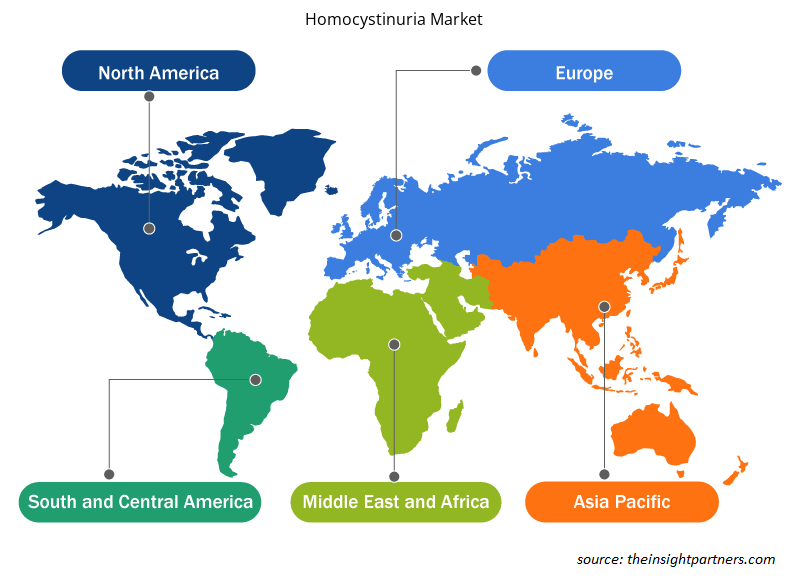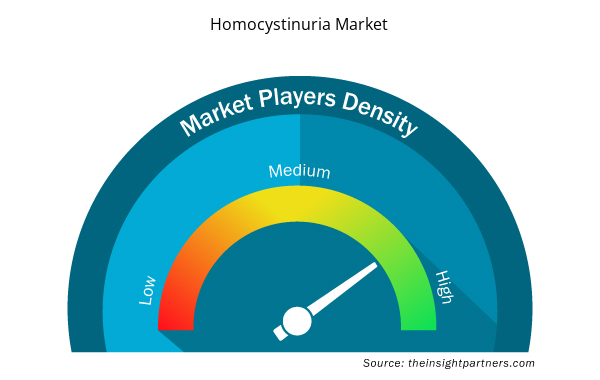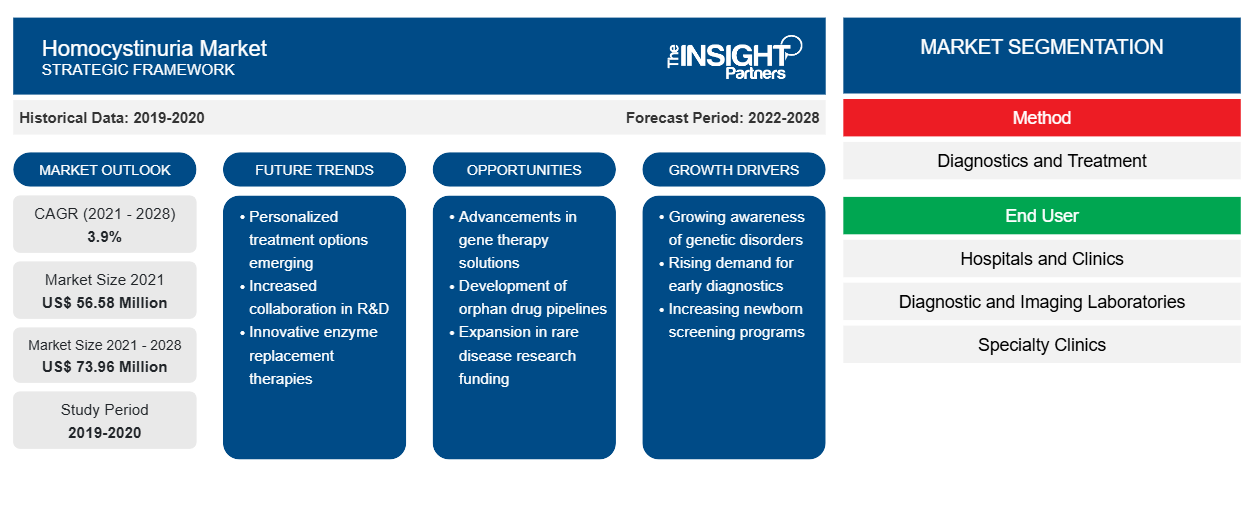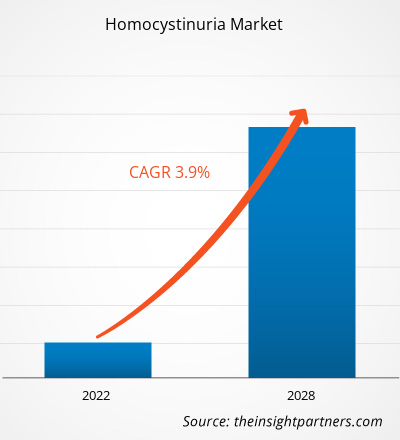من المتوقع أن يصل سوق الهوموسيستينوريا إلى 73.96 مليون دولار أمريكي بحلول عام 2028 من 56.58 مليون دولار أمريكي في عام 2021؛ ومن المتوقع أن ينمو بمعدل نمو سنوي مركب قدره 3.9٪ خلال الفترة 2021-2028.
بيلة الهوموسيستين هي حالة وراثية حيث لا يستطيع الجسم هضم بعض اللبنات الأساسية للبروتين (الأحماض الأمينية) بشكل صحيح. تأتي بيلة الهوموسيستين في مجموعة متنوعة من الأنواع، ولكل منها مجموعة خاصة من العلامات والأعراض بالإضافة إلى السبب الوراثي. قصر النظر (قصر النظر)، وخلع العدسة في مقدمة العين، وزيادة خطر تجلط الدم غير المنتظم، وهشاشة العظام المعرضة للكسر (هشاشة العظام) أو غيرها من التشوهات الهيكلية هي الشكل الأكثر انتشارًا لبيلة الهوموسيستين. يعاني بعض الأشخاص المتأثرين أيضًا من تأخير النمو وصعوبات التعلم.
قم بتخصيص هذا التقرير ليناسب متطلباتك
ستحصل على تخصيص لأي تقرير - مجانًا - بما في ذلك أجزاء من هذا التقرير، أو تحليل على مستوى الدولة، وحزمة بيانات Excel، بالإضافة إلى الاستفادة من العروض والخصومات الرائعة للشركات الناشئة والجامعات
- احصل على أهم اتجاهات السوق الرئيسية لهذا التقرير.ستتضمن هذه العينة المجانية تحليلاً للبيانات، بدءًا من اتجاهات السوق وحتى التقديرات والتوقعات.
يعود نمو سوق بيلة الهوموسيستين إلى نقص فيتامين ب6 وفيتامين ب12 المتزايد وانتشار الاضطرابات الأيضية الوراثية. ومع ذلك، فإن الافتقار إلى الوعي حول الاضطرابات النادرة المختلفة والاضطرابات الأيضية الوراثية يعوق نمو السوق.
رؤى السوق
ارتفاع حالات نقص فيتامين ب6 وفيتامين ب12 يؤدي إلى زيادة سوق بيلة الهوموسيستين
يؤدي ارتفاع أنماط نقص فيتامين ب6 وفيتامين ب12 إلى العديد من الاضطرابات مثل فقر الدم وفقر الدم الضخم الأرومات وفقر الدم الصغير الخلايا وبعض أنواع الاضطرابات الأيضية، ومن المتوقع أن يعزز نمو السوق خلال فترة التنبؤ. نظرًا لأن علاج فيتامين ب6 يُعتقد أنه علاج فعال ضد بيلة الهوموسيستين، فقد يؤدي نقص هذا الفيتامين إلى تفاقم الحالة. يعمل البيريدوكسين (فيتامين ب6) كعامل مساعد لبيتا سينثاز ويعمل كمرافق لتثبيت العديد من الطفرات غير المتجانسة. يستجيب بعض المرضى المصابين ببيلة الهوموسيستين بشكل جيد لعلاج البيريدوكسين، ويساعد في خفض مستويات الهوموسيستين، وبالتالي توفير الراحة من الحالة. وبالتالي، يعتبر فيتامين ب6 حيويًا في إدارة بيلة الهوموسيستين حيث يتوفر عدد محدود من العلاجات لعلاج الحالة. يؤدي نقص هذا الإنزيم إلى فقر الدم وفقر الدم الصغير الخلايا. ومن المتوقع أن يؤدي انتشار فقر الدم المتزايد إلى تحفيز نمو السوق خلال فترة التنبؤ. على سبيل المثال، وفقًا لمنظمة الصحة العالمية، يؤثر فقر الدم على أكثر من 1.62 مليار نسمة، أي 24.8% من السكان. الأسباب الرئيسية لفقر الدم هي النظام الغذائي غير السليم ونقص الفيتامينات مثل B6 وB9 وB12. في الغالب، يعد نقص فيتامين B6 السبب الرئيسي لفقر الدم. وبالتالي، من المتوقع أن تدعم الزيادة في حالات نقص فيتامين B6 وانتشار الاضطرابات المرتبطة بنقصه نمو السوق خلال فترة التنبؤ.
رؤى مبنية على الطريقة
ينقسم سوق بيلة الهوموسيستين العالمية، بناءً على الطريقة، إلى العلاج والتشخيص. احتل قطاع العلاج حصة أكبر من السوق في عام 2021. علاوة على ذلك، من المتوقع أن يسجل نفس القطاع معدل نمو سنوي مركب أعلى في السوق خلال فترة التوقعات بسبب الاستخدام الحالي للعلاج وزيادة البحث والتطوير لعلاجات جديدة لبيلة الهوموسيستين.
رؤى إقليمية حول سوق الهوموسيستينوريا
لقد قام المحللون في Insight Partners بشرح الاتجاهات والعوامل الإقليمية المؤثرة على سوق الهوموسيستينوريا طوال فترة التوقعات بشكل شامل. يناقش هذا القسم أيضًا قطاعات سوق الهوموسيستينوريا والجغرافيا في جميع أنحاء أمريكا الشمالية وأوروبا ومنطقة آسيا والمحيط الهادئ والشرق الأوسط وأفريقيا وأمريكا الجنوبية والوسطى.

- احصل على البيانات الإقليمية المحددة لسوق الهوموسيستينوريا
نطاق تقرير سوق هوموسيستينوريا
| سمة التقرير | تفاصيل |
|---|---|
| حجم السوق في عام 2021 | 56.58 مليون دولار أمريكي |
| حجم السوق بحلول عام 2028 | 73.96 مليون دولار أمريكي |
| معدل النمو السنوي المركب العالمي (2021 - 2028) | 3.9% |
| البيانات التاريخية | 2019-2020 |
| فترة التنبؤ | 2022-2028 |
| القطاعات المغطاة | حسب الطريقة
|
| المناطق والدول المغطاة | أمريكا الشمالية
|
| قادة السوق وملفات تعريف الشركات الرئيسية |
|
كثافة اللاعبين في سوق الهوموسيستينوريا: فهم تأثيرها على ديناميكيات الأعمال
يشهد سوق هوموسيستينوريا نموًا سريعًا، مدفوعًا بالطلب المتزايد من المستخدم النهائي بسبب عوامل مثل تفضيلات المستهلكين المتطورة والتقدم التكنولوجي والوعي المتزايد بفوائد المنتج. ومع ارتفاع الطلب، تعمل الشركات على توسيع عروضها والابتكار لتلبية احتياجات المستهلكين والاستفادة من الاتجاهات الناشئة، مما يؤدي إلى زيادة نمو السوق.
تشير كثافة اللاعبين في السوق إلى توزيع الشركات أو المؤسسات العاملة في سوق أو صناعة معينة. وهي تشير إلى عدد المنافسين (اللاعبين في السوق) الموجودين في مساحة سوق معينة نسبة إلى حجمها أو قيمتها السوقية الإجمالية.
الشركات الرئيسية العاملة في سوق الهوموسيستينوريا هي:
- باسف اس اي
- شركة هوازونغ للصناعات الدوائية
- شركة فايزر
- ميلان نيفادا
- ايجليا بيوثيرابيوتيكس
إخلاء المسؤولية : الشركات المذكورة أعلاه ليست مرتبة بأي ترتيب معين.

- احصل على نظرة عامة على أهم اللاعبين الرئيسيين في سوق الهوموسيستينوريا
رؤى تعتمد على المستخدم النهائي
ينقسم سوق الهوموسيستينوريا العالمي، بناءً على المستخدم النهائي، إلى مختبرات التشخيص والتصوير والمستشفيات والعيادات والعيادات التخصصية والمعاهد الأكاديمية والبحثية. في عام 2021، استحوذ قطاع مختبرات التشخيص والتصوير على الحصة الأكبر من السوق. علاوة على ذلك، من المتوقع أن يسجل القطاع أعلى معدل نمو سنوي مركب بنسبة 4.2% خلال الفترة 2021-2028 بسبب ارتفاع تشخيص الاضطرابات الأيضية الوراثية في مختبرات التشخيص والتصوير.
إن إطلاق المنتجات والموافقة عليها هي عادة استراتيجيات تتبناها الشركات لتوسيع نطاق وجودها العالمي ومحافظ منتجاتها. وعلاوة على ذلك، يركز اللاعبون في سوق بيلة الهوموسيستين على استراتيجية الشراكة لتوسيع قاعدة عملائهم، الأمر الذي يسمح لهم بدوره بالحفاظ على اسم علامتهم التجارية في جميع أنحاء العالم.
يقسم التقرير سوق الهوموسيستينوريا على النحو التالي
سوق الهوموسيستينوريا – حسب الطريقة
- علاج
- البيريدوكسين
- البيتين
- آحرون
- التشخيص
- الاختبارات الجينية
- اختبار فحص الأحماض الأمينية
- اختبار إنزيمات الكبد
- آحرون
سوق الهوموسيستينوريا – حسب المستخدم النهائي
- المستشفيات والعيادات
- مختبرات التشخيص والتصوير
- عيادات متخصصة
- المؤسسات الأكاديمية والبحثية
سوق الهوموسيستينوريا – حسب المنطقة الجغرافية
- أمريكا الشمالية
- نحن
- كندا
- المكسيك
- أوروبا
- المملكة المتحدة
- ألمانيا
- فرنسا
- إيطاليا
- إسبانيا
- بقية أوروبا
- آسيا والمحيط الهادئ
- الصين
- اليابان
- الهند
- أستراليا
- كوريا الجنوبية
- بقية آسيا والمحيط الهادئ
- الشرق الأوسط وأفريقيا
- الامارات العربية المتحدة
- المملكة العربية السعودية
- جنوب أفريقيا
- بقية الشرق الأوسط وأفريقيا
- أمريكا الجنوبية والوسطى
- البرازيل
- الأرجنتين
- بقية أمريكا الجنوبية والوسطى
نبذة عن الشركة
- باسف اس اي
- شركة هوازونغ للصناعات الدوائية
- شركة فايزر
- ميلان نيفادا
- ايجليا بيوثيرابيوتيكس
- أمينو المحدودة
- شركة كاو
- شركة دي إس إم
- تكنولوجيات الأيتام
- شركة فريسينيوس كابي ايه جي
- التحليل التاريخي (سنتان)، السنة الأساسية، التوقعات (7 سنوات) مع معدل النمو السنوي المركب
- تحليل PEST و SWOT
- حجم السوق والقيمة / الحجم - عالميًا وإقليميًا وقطريًا
- الصناعة والمنافسة
- مجموعة بيانات Excel



Report Coverage
Revenue forecast, Company Analysis, Industry landscape, Growth factors, and Trends

Segment Covered
This text is related
to segments covered.

Regional Scope
North America, Europe, Asia Pacific, Middle East & Africa, South & Central America

Country Scope
This text is related
to country scope.
الأسئلة الشائعة
The Asia Pacific region is expected to be the fastest-growing region among all other regions. The market in this region is expected to grow significantly in countries such as, China, Japan and India. The market is driven by increase in prevalence of inherited metabolic disorders, rise in government initiatives to manage rare diseases across the region along with increase in diagnostic tests across the region such as new born screening test etc. Therefore, the region holds huge potential for the homocystinuria market players to grow during the forecast period.
Homocystinuria is an inherited disorder in which the body is unable to process certain building blocks of proteins (amino acids) properly. There are multiple forms of homocystinuria, which are distinguished by their signs and symptoms and genetic cause. The most common form of homocystinuria is characterized by nearsightedness (myopia), dislocation of the lens at the front of the eye, an increased risk of abnormal blood clotting, and brittle bones that are prone to fracture (osteoporosis) or other skeletal abnormalities. Some affected individuals also have developmental delay and learning problems.
The growth of the Homocystinuria market is mainly attributed to factors such as the increasing prevalence of inherited metabolic disorders coupled with rise in vitamin B6 and Vitamin B12 deficiencies. However, the lack of awareness about various rare disorders and inherited metabolic disorders is hindering the market growth.
The global Homocystinuria market is expected to reach US$ 73,960.22 thousand by 2028 from US$ 56,589.20 thousand in 2021; it is estimated to grow at a CAGR of 3.9% during 2021-2028.
Emergence of human enzyme therapeutics and enzyme replacement therapy to treat rare disorders is one of the future trends of homocystinuria market. Enzyme replacement therapy and enzyme therapeutics is a type of novel drug therapy in which therapeutic enzymes are used to treat chronic and life-threatening diseases such as cancer, idiosyncratic disorders, and rare disorders. Furthermore, if an enzyme is not functioning properly in the body, then enzyme replacement therapy is used for replacing the enzyme that is deficient in the body. Enzymes have a predominant role in pharmaceutical industries and drug development as they treat various disorders. The advancements in the field of protein technology, recombinant DNA technology, enzyme immobilization, and nanotechnology have provided a solid platform for the use of enzymes in the treatment of various disorders.
Trends and growth analysis reports related to Life Sciences : READ MORE..
The List of Companies - Homocystinuria Market
- BASF SE
- HUAZHONG PHARMACEUTICAL
- Pfizer Inc.
- MYLAN N.V
- Aeglea BioTherapeutics
- Amino GMBH
- KAO Corporation
- DSM Corporation
- Orphan Technologies
- Fresenius Kabi AG.
The Insight Partners performs research in 4 major stages: Data Collection & Secondary Research, Primary Research, Data Analysis and Data Triangulation & Final Review.
- Data Collection and Secondary Research:
As a market research and consulting firm operating from a decade, we have published and advised several client across the globe. First step for any study will start with an assessment of currently available data and insights from existing reports. Further, historical and current market information is collected from Investor Presentations, Annual Reports, SEC Filings, etc., and other information related to company’s performance and market positioning are gathered from Paid Databases (Factiva, Hoovers, and Reuters) and various other publications available in public domain.
Several associations trade associates, technical forums, institutes, societies and organization are accessed to gain technical as well as market related insights through their publications such as research papers, blogs and press releases related to the studies are referred to get cues about the market. Further, white papers, journals, magazines, and other news articles published in last 3 years are scrutinized and analyzed to understand the current market trends.
- Primary Research:
The primarily interview analysis comprise of data obtained from industry participants interview and answers to survey questions gathered by in-house primary team.
For primary research, interviews are conducted with industry experts/CEOs/Marketing Managers/VPs/Subject Matter Experts from both demand and supply side to get a 360-degree view of the market. The primary team conducts several interviews based on the complexity of the markets to understand the various market trends and dynamics which makes research more credible and precise.
A typical research interview fulfils the following functions:
- Provides first-hand information on the market size, market trends, growth trends, competitive landscape, and outlook
- Validates and strengthens in-house secondary research findings
- Develops the analysis team’s expertise and market understanding
Primary research involves email interactions and telephone interviews for each market, category, segment, and sub-segment across geographies. The participants who typically take part in such a process include, but are not limited to:
- Industry participants: VPs, business development managers, market intelligence managers and national sales managers
- Outside experts: Valuation experts, research analysts and key opinion leaders specializing in the electronics and semiconductor industry.
Below is the breakup of our primary respondents by company, designation, and region:

Once we receive the confirmation from primary research sources or primary respondents, we finalize the base year market estimation and forecast the data as per the macroeconomic and microeconomic factors assessed during data collection.
- Data Analysis:
Once data is validated through both secondary as well as primary respondents, we finalize the market estimations by hypothesis formulation and factor analysis at regional and country level.
- Macro-Economic Factor Analysis:
We analyse macroeconomic indicators such the gross domestic product (GDP), increase in the demand for goods and services across industries, technological advancement, regional economic growth, governmental policies, the influence of COVID-19, PEST analysis, and other aspects. This analysis aids in setting benchmarks for various nations/regions and approximating market splits. Additionally, the general trend of the aforementioned components aid in determining the market's development possibilities.
- Country Level Data:
Various factors that are especially aligned to the country are taken into account to determine the market size for a certain area and country, including the presence of vendors, such as headquarters and offices, the country's GDP, demand patterns, and industry growth. To comprehend the market dynamics for the nation, a number of growth variables, inhibitors, application areas, and current market trends are researched. The aforementioned elements aid in determining the country's overall market's growth potential.
- Company Profile:
The “Table of Contents” is formulated by listing and analyzing more than 25 - 30 companies operating in the market ecosystem across geographies. However, we profile only 10 companies as a standard practice in our syndicate reports. These 10 companies comprise leading, emerging, and regional players. Nonetheless, our analysis is not restricted to the 10 listed companies, we also analyze other companies present in the market to develop a holistic view and understand the prevailing trends. The “Company Profiles” section in the report covers key facts, business description, products & services, financial information, SWOT analysis, and key developments. The financial information presented is extracted from the annual reports and official documents of the publicly listed companies. Upon collecting the information for the sections of respective companies, we verify them via various primary sources and then compile the data in respective company profiles. The company level information helps us in deriving the base number as well as in forecasting the market size.
- Developing Base Number:
Aggregation of sales statistics (2020-2022) and macro-economic factor, and other secondary and primary research insights are utilized to arrive at base number and related market shares for 2022. The data gaps are identified in this step and relevant market data is analyzed, collected from paid primary interviews or databases. On finalizing the base year market size, forecasts are developed on the basis of macro-economic, industry and market growth factors and company level analysis.
- Data Triangulation and Final Review:
The market findings and base year market size calculations are validated from supply as well as demand side. Demand side validations are based on macro-economic factor analysis and benchmarks for respective regions and countries. In case of supply side validations, revenues of major companies are estimated (in case not available) based on industry benchmark, approximate number of employees, product portfolio, and primary interviews revenues are gathered. Further revenue from target product/service segment is assessed to avoid overshooting of market statistics. In case of heavy deviations between supply and demand side values, all thes steps are repeated to achieve synchronization.
We follow an iterative model, wherein we share our research findings with Subject Matter Experts (SME’s) and Key Opinion Leaders (KOLs) until consensus view of the market is not formulated – this model negates any drastic deviation in the opinions of experts. Only validated and universally acceptable research findings are quoted in our reports.
We have important check points that we use to validate our research findings – which we call – data triangulation, where we validate the information, we generate from secondary sources with primary interviews and then we re-validate with our internal data bases and Subject matter experts. This comprehensive model enables us to deliver high quality, reliable data in shortest possible time.


 احصل على عينة مجانية لهذا التقرير
احصل على عينة مجانية لهذا التقرير